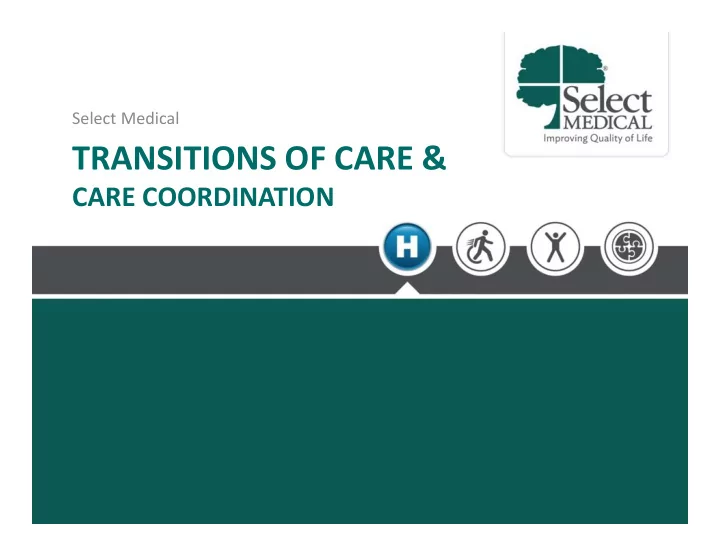

Select Medical TRANSITIONS OF CARE & CARE COORDINATION
Agenda • Select Medical Overview • Transitions of Care – Right Patient, Right Level of Care, Right Time Right Patient, Right Level of Care, Right Time – Chronic Critical Illness Syndrome – Role of Long Term Acute Care Hospital (LTACH) • Care Coordination – Pre ‐ care – Point of Care – Post ‐ care 2
Select Medical Overview
Select Medical’s National Footprint 2 5 12 4 1 1 2 2 2 3 3 8 8 4 4 24 4 1 11 2 8 18 148 2 3 17 44 4 1 11 2 13 10 7 9 2 3 2 11 3 11 131 45 8 3 153 23 15 13 49 1 5 7 1 3 1 1 1 58 1 12 1 17 17 3 3 17 17 1 35 21 3 10 16 3 20 17 21 2 3 43 2 1 2 3 15 4 2 4 2 2 66 32 6 11 3 1 3 14 13 2 5 7 5 4 2 1 2 8 6 12 15 1 2 20 1 1 2 2 6 6 2 2 1 1 2 9 14 17 6 24 2 4 5 As of 6/30/15 7 46 6 97 1 3 94 56 1 1 10 8 1 427 Contract 1,028 Outpatient 111 Long ‐ Term Acute 17 Inpatient Rehabilitation Therapy Locations Rehabilitation Centers Care Hospitals (LTACH) p ( ) 300 Concentra Centers Hospitals Hospitals (28 States and D.C.) (31 States and D.C.) (28 States) (38 States) (8 States) 4
5
Transitions of Care
Continuum of Care Right Patient, Right Level of Care, Right Time 7
8 Admission Scenarios – Study Example
Chronic Critical Illness (CCI) • High acuity, medically complex with multi organ system failure • Frequently requires prolonged mechanical ventilation • Distinct clinical group of patients with distinct pathophysiology and care needs when compared to acutely critically ill patients • Post Intensive Care Syndrome (PICS) P I i C S d (PICS) 9
Chronic Co-Morbidities Acute Critical Illness Medical Surgical Chronic Critical Illness Ventilator Dependence Brain Dysfunction Neuromuscular Weakness Endocrinopathy Malnutrition Anasarca Skin Breakdown Symptom Distress Neurologic g Cardiac Sepsis/Acute Co-Morbidities Older Age Am J Respir Crit Care Med Vol 182. pp 446–454, 2010
CCI Discharge Options: CHEST, 2005 Level of Care Acuity Level Advantage Disadvantage Acute ICU Patient may be unstable Hi Tech interventions as well Cost as full ICU care as full ICU care Focused on acute needs Focused on acute needs (cardiac cath, Pulmonary Not skilled in CCIS Artery Cath, Full OR) Acute Lower cost Hi tech interventions with Focused on short stays Step-down Patients usually stable transfer back to ICU Not Skilled in CCIS LTACH Patients may be unstable Specialize in CCIS Some focused interventions as long as acute care Clinical Team and Patient available (GI procedures, interventions not needed Focused debridements, Respiratory Lower cost procedures, basic diagnostics) p g ) Physician Coverage Patient focused Sub-acute SNF Patients must be stable Cost No on-site interventions, clinical Family access team not skilled in CCIS and Patient focused Patient focused ratios much lower ratios much lower No daily physician coverage SNF Patients must be stable Cost Staffing ratios and recovering Appropriate clinical services No on-site interventions No daily physician coverage Acute Must be stable and able Rehab and mobility focused CCIS pt often not ready for this Rehabilitation to meet rehab criteria level 11
Role of LTACH • Specialized ACUTE Care Environment – Evidence Based Treatments and Protocols E id B d T t t d P t l • Interdisciplinary Team Focus and Intensity of Service – Patient Centered • Serves a Critical Role in Facilitating Functional Outcomes g – Environment and Skillset for Early Mobilization of CCI Patients 12
Care Coordination
Care Coordination Focus and Innovation Pre ‐ Care Point of Care Post ‐ Care Screening • Care Conference Level of Care • • • Clinical Criteria • IDT Meeting • Clinical Capabilities • Preparation • DC Planning • Communication • Communication • DC Preparation • Patient Satisfaction • Facility Hand ‐ off F ili H d ff • Communication C i i Patient/Family • Patient Engagement 14
Point of Care ‐ Case Management/UR Organized Interdisciplinary Workflow •Clinical Barrier Resolution •Clinical Barrier Resolution •Treatment Plan Physician POC Progression •Interdisciplinary Approach REHAB Admitting •Discharge Diagnosis Planning •Community Barrier Resolution Patient/ Discharge DC •Resource Barrier Resolution Treatment Treatment HOME SNF Planning Plan Team LLOC Family •Nationalized Nationalized Severity LOS Resource and •Utilization Review of Illness •UR/UM LOS •Outlier Management OTHER Managemen t Case Manager 15
Key Points – Care Coordination • Appropriate Transitions of Care • Patient Centered Care Planning • Multi ‐ Discipline Team Focused Treatment Plans • Flow of Information and Education for Patients and Providers • Innovations in Care Delivery and Coordination of Care 16
Thank you For additional information or questions: David Key, SVP Operations Select Medical 4714 Gettysburg Rd Mechanicsburg, PA 17055 dkey@selectmedical com dkey@selectmedical.com (717) 730 ‐ 4231
Recommend
More recommend